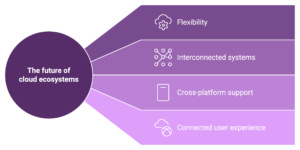IT’s pushback is making services better for everyone
IT managers are making waves by raising tough questions about cloud usage. They’re concerned with the high price tags, limited control, and the sense that the cloud isn’t quite delivering the returns it promised. And this isn’t a quiet complaint. These voices are making waves in the industry, forcing cloud providers to pause and reconsider how they can bring more value to the table.
Cloud vendors are responding with transparency tools and better governance capabilities, opening the doors to a more tailored and adaptable cloud experience. It’s no longer about dumping data in a virtual space and hoping for the best. Now, it’s about building a service that truly fits the enterprise’s blueprint. This pressure from IT is resetting the relationship dynamics, and vendors are finally getting serious about offering solutions that address these core business needs.
Cloud providers are becoming “true partners”
Today, companies don’t want generic cloud solutions, they want a service that gets their industry, down to the last detail. Cloud providers are moving fast to meet this demand, pushing past one-size-fits-all models to create offerings that check every box on compliance, regulations, and business objectives.
It’s a shift that goes beyond technology for its own sake. Cloud vendors are starting to act less like simple tech suppliers and more like strategic partners, crafting solutions that seamlessly blend into each business’s operational strategy. As this shift picks up speed, companies gain access to clouds that push beyond simple data storage, and instead serve as an extension of their mission and goals.
Financial strategy and smart choices impact cloud adoption
In the cloud world, financial strategy is everything. IT professionals aren’t only looking at performance, they’re keeping a close eye on cost efficiency. FinOps, the blend of finance and operations in cloud management, is becoming the standard for cost management, helping teams make sense of every dollar spent on the cloud.
FinOps is a system that looks at cloud costs from every angle, breaking down how and where funds are allocated.
Professionals are also making their way toward hybrid and multicloud setups, choosing them to avoid the risk of over-reliance on a single vendor. These setups let companies cherry-pick the most suitable and cost-effective environments for each workload, aligning business needs with the right tech infrastructure.
Hybrid and multicloud setups are the choice for enterprises serious about flexibility and cost-effectiveness. These models create a comprehensive safety net by letting organizations split their dependencies across multiple providers, which reduces the impact of any single vendor issue.
The overarching focus here isn’t on choosing multiple providers for the sake of variety, it’s a smart strategy that matches each workload to the best platform for it, optimizing both performance and cost across operations.
Cloud providers are adapting to work better with on-prem and multicloud needs
The message from IT leaders is clear: we need options. Enterprises want solutions that work seamlessly with on-premises systems, blend easily with other cloud platforms, and don’t lock them into one vendor. Cloud providers are taking note, improving their compatibility to support multicloud and hybrid models.
It’s an evolving approach that aims to go beyond the old idea of one-size-fits-all public cloud. It’s a recognition that enterprises want flexibility and that a mixed, interconnected ecosystem is the future. As providers lean into this, they’re creating stronger support for cross-platform solutions, which in turn drives a more seamless, connected user experience across different cloud infrastructures.

The future of cloud ecosystems
Cloud-enterprise partnerships are making IT more resilient and adaptive
IT’s critiques, while shaping the market, aim to build a stronger foundation for the cloud’s future. Cloud providers and enterprises are forming real partnerships focused on delivering solutions that can handle today’s unpredictable shifts. This collaborative model doesn’t focus on creating one-size-fits-all products, it’s developing an adaptive infrastructure that can respond to real-time business changes and support companies through any transformation.
A partnership-led approach brings resilience into the IT structure, letting companies stay nimble and responsive as demands evolve. In this way, cloud computing stays relevant and even essential to modern business operations, able to scale and flex with every new challenge or opportunity that comes its way.
Final thoughts
So, here’s the question you need to seriously ask: is your cloud strategy doing nothing more than keeping up, or is it actually moving you ahead? The shift in cloud computing is about real control, cost-effectiveness, and relevance in a fast-evolving market. Think beyond the public cloud hype: are you strategically positioned to adapt, pivot, and succeed?





